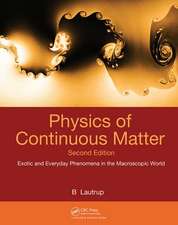Nonlinear Stability and Bifurcation Theory: An Introduction for Engineers and Applied Scientists
Autor Hans Troger, Alois Steindlen Limba Engleză Paperback – 15 oct 1991
Preț: 398.92 lei
Nou
Puncte Express: 598
Preț estimativ în valută:
76.33€ • 79.90$ • 63.53£
76.33€ • 79.90$ • 63.53£
Carte tipărită la comandă
Livrare economică 31 martie-14 aprilie
Preluare comenzi: 021 569.72.76
Specificații
ISBN-13: 9783211822920
ISBN-10: 3211822925
Pagini: 424
Ilustrații: XI, 407 p.
Dimensiuni: 170 x 244 x 22 mm
Greutate: 0.67 kg
Ediția:Softcover reprint of the original 1st ed. 1991
Editura: SPRINGER VIENNA
Colecția Springer
Locul publicării:Vienna, Austria
ISBN-10: 3211822925
Pagini: 424
Ilustrații: XI, 407 p.
Dimensiuni: 170 x 244 x 22 mm
Greutate: 0.67 kg
Ediția:Softcover reprint of the original 1st ed. 1991
Editura: SPRINGER VIENNA
Colecția Springer
Locul publicării:Vienna, Austria
Public țintă
ResearchCuprins
1 Introduction.- 2 Representation of systems.- 2.1 Dynamical systems.- 2.2 Statical systems.- 2.3 Definitions of stability.- 3 Reduction process, bifurcation equations.- 3.1 Finite-dimensional dynamical systems.- 3.2 Infinite-dimensional statical and dynamical systems..- 4 Application of the reduction process.- 4.1 Equilibria of finite-dimensional systems.- 4.2 Periodic solutions of finite-dimensional systems.- 4.3 Finite- and infinite-dimensional statical systems.- 5 Bifurcations under symmetries.- 5.1 Introduction.- 5.2 Finite dimensional dynamical systems.- 5.3 Infinite dimensional statical systems.- 5.4 Infinite dimensional dynamical systems.- 6 Discussion of the bifurcation equations.- 6.1 Transformation to normal form.- 6.2 Codimension.- 6.3 Determinacy.- 6.4 Unfolding.- 6.5 Classification.- 6.6 Bifurcation diagrams.- A Linear spaces and linear operators.- A.1 Linear spaces.- A.2 Linear operators.- B Transformation of matrices to Jordan form.- C Adjoint and self-adjoint linear differential operators.- C.1 Calculation of the adjoint operator.- C.2 Self-adjoint differential operators.- D Projection operators.- D.1 General considerations.- D.2 Projection for non-self-adjoint operators.- D.3 Application to the Galerkin reduction.- E Spectral decomposition.- E.1 Derivation of an inversion formula.- E.2 Three examples.- F Shell equations on the complete sphere.- F.1 Tensor notations in curvilinear coordinates.- F.2 Spherical harmonics.- G Some properties of groups.- G.1 Naive definition of a group.- G.2 Symmetry groups.- G.3 Representation of groups by matrices.- G.4 Transformation of functions and operators.- G.5 Examples of invariant functions and operators.- G.6 Abstract definition of a group.- H Stability boundaries in parameter space.- I Differential equation of anelastic ring.- I.1 Equilibrium equations and bending.- I.2 Ring equations.- J Shallow shell and plate equations.- J.1 Deformation of the shell.- J.2 Constitutive law.- J.3 Equations of equilibrium.- J.4 Special cases.- J.4.1 Plate.- J.4.2 Sphere.- J.4.3 Cylinder.- K Shell equations for axisymmetric deformations.- K.1 Geometrical relations.- K.2 Stress resultants, couples and equilibrium equations.- K.3 Stress strain relations.- K.4 Spherical shell.- L Equations of motion of a fluid conveying tube.- L.1 Geometry of tube deformation.- L.2 Stress-strain relationship.- L.3 Linear and angular momentum.- L.4 Tube equations and boundary conditions.- M Various concepts of equivalences.- M.1 Right-equivalence.- M.2 Contact equivalence.- M.3 Vector field equivalence.- M.4 Bifurcation equivalence.- M.5 Recognition problem.- N Slowly varying parameter.- O Transformation of dynamical systems into standard form.- O.1 Power series expansion.- O.2 Recursive calculation.












